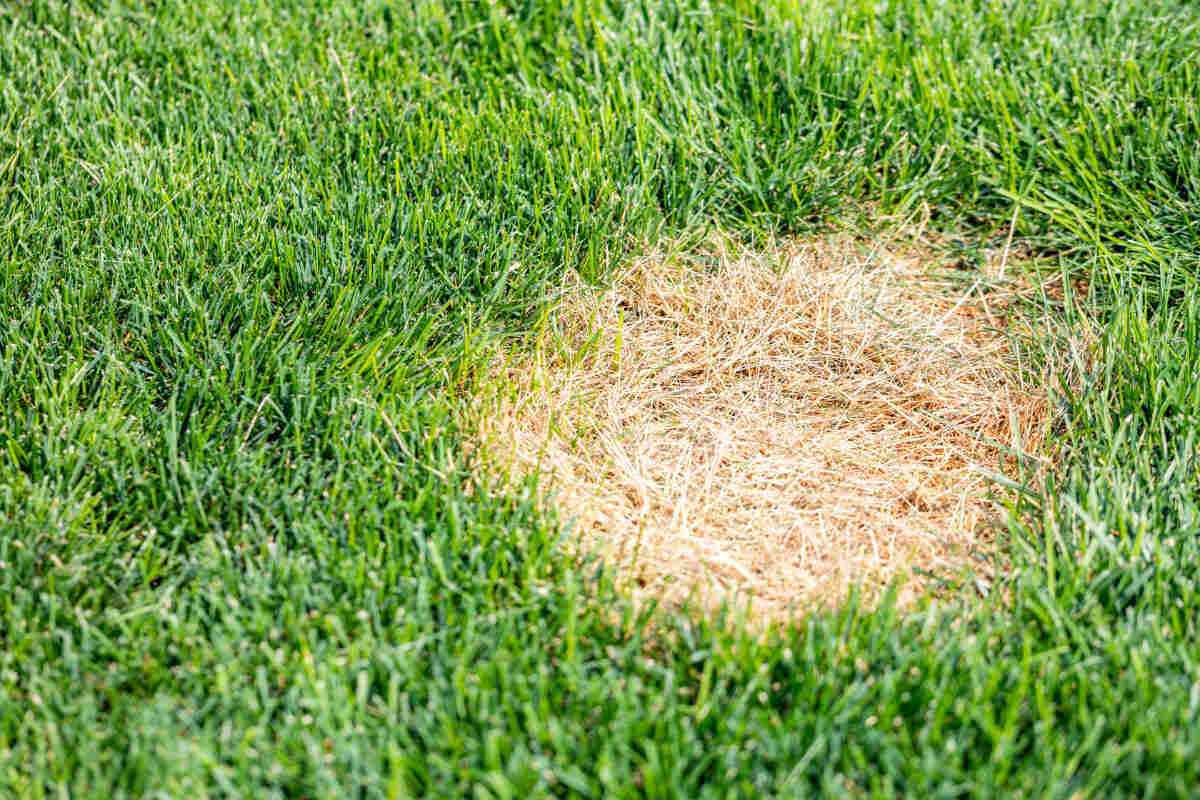
You look outside at your once beautiful, green lawn and now see dying patches of turf, and you think to yourself, ‘why does my lawn have brown spots?’ This article will give you 13 possible reasons for this common problem.
The good news is that you can fix many of these ailments with proper lawn care techniques. Some possibilities for brown spots on your lawn include compacted soil, fungal diseases, pests, and poor soil quality.
1. Compacted Soil
When soil becomes compacted, your lawn can’t receive the water, air, and nutrients it needs to thrive, making it develop brown spots.
Every-day foot traffic, heavy rainfall, and vehicles can compact the soil beneath your lawn. To check for soil compaction, try sticking a screwdriver into the soil. If the screwdriver enters the ground with ease, the soil likely isn’t compacted. But if you struggle to pierce the soil, then the soil is probably compacted.
Solution: Your lawn will need an aeration service to combat compacted soil. Core aeration removes plugs of soil from the ground to allow water, air, and nutrients to deliver appropriately. The removal of these plugs also creates room for roots to grow deeper and reduces thatch build-up.
2. Poor pH Levels
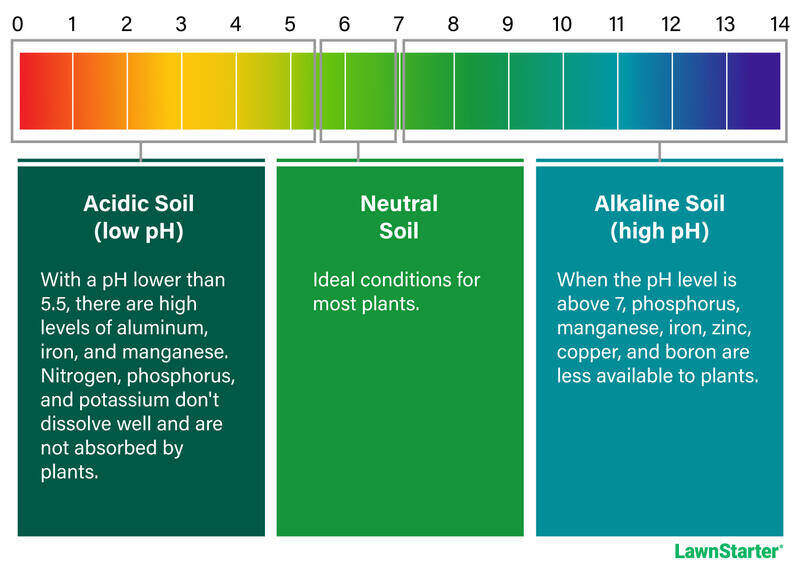
Not only can compacted soil cause brown spots, but soil pH levels that are too high or too low can also brown turfgrass. A healthy lawn needs a soil pH level between 6.0 and 7.0–– slightly acidic to neutral.
When pH is off balance, your lawn can’t properly absorb nutrients. This can eventually cause brown spots or reduced growth.
Solution: Soil amendments like lime or sulfur can be applied to correct soil pH. But before you run to the home improvement store to buy a soil amendment, submit a soil sample to your local county extension office to determine the exact treatment your soil needs.
3. Thatch Build-Up
Thatch is the layer of living and dead organic matter intertwined between the soil and the grass. Some thatch accumulation is normal and beneficial (less than one-half inch) because it can insulate your grass during the colder months.
But when thatch becomes too thick (one-half inch or greater), your grass can’t receive the nutrients, air, and water it needs to grow a deep root system. As a result, your turf may develop brown spots.
Because thatch puts your lawn in a weakened state, the lawn also becomes susceptible to pests and diseases that cause brown spots. Thatch also encourages pests because it provides them with food and shelter.
Solution: Dethatch warm-season lawns in late spring or early summer and dethatch cool-season lawns in early fall.
4. Fungal Diseases
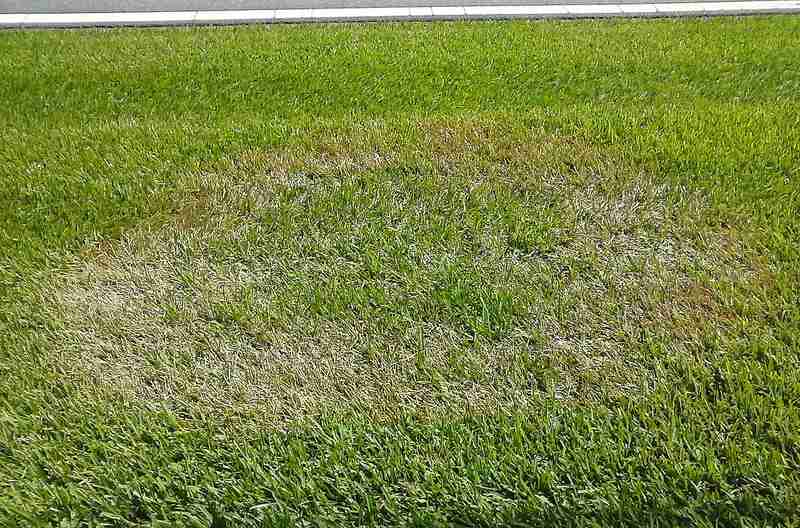
Photo Credit: Scot Nelson / Wikimedia Commons / CC0 1.0
Fungal diseases can turn the greenest of lawns brown very quickly. They need prompt attention to contain and correct them before they take over your entire lawn.
Some common fungal lawn diseases that could leave you with brown spots include:
- Brown patch: As the name suggests, you may notice irregular brown patches develop on the lawn. This disease flourishes in hot and humid weather.
- Take-all root rot: Take-all root rot can be tricky to diagnose at first because the damage is similar to what a lawn looks like when it has a lack of nutrients or chinch bug damage. Upon further inspection, you may notice yellow grass blades that eventually turn brown and wilt. The irregular brown spots can expand between 1 to 20 feet.
- Dollar spot: The name dollar spot comes from the initial brown spots that are the size of a silver dollar coin. Those spots can grow together and create larger brown spots on your lawn.
- Gray leaf spot: Gray leaf spot starts as small brown spots that can quickly become large circular or oval-shaped spots. The fungus, Pyricularia grisea, produces a cottony fungal growth, giving the fungal disease its name.
- Fairy ring: Type 1 fairy ring can cause brown spots on lawns. With type 1, the fungi make it difficult for the grass to absorb water.
Tip: Don’t mow your lawn if a fungal disease is present. You could spread the disease more throughout your lawn by mowing.
Solution: Aeration, dethatching, proper fertilization, and proper watering techniques reduce the risk of fungal diseases.
5. Pests
There are several lawn pests that can cause brown spots on your lawn.
- Grubs cause brown spots by eating the roots of your grass. Brown spots from grubs will start small but, if left untreated, can turn into widespread brown spots.
- Chinch bugs leave irregular brown spots on your lawn by piercing the grass with their mouths and taking the nutrients intended for your lawn.
- Armyworms can leave your grass with brown spots or ragged blades as they feed on it.
- Sod webworms are nocturnal pests that can cause your grass to have a grazed appearance or brown spots.
Solution: A healthy lawn is less susceptible to lawn pests. Proper mowing, watering, and regular fertilizing can create a healthier lawn.
6. Too Much Fertilizer
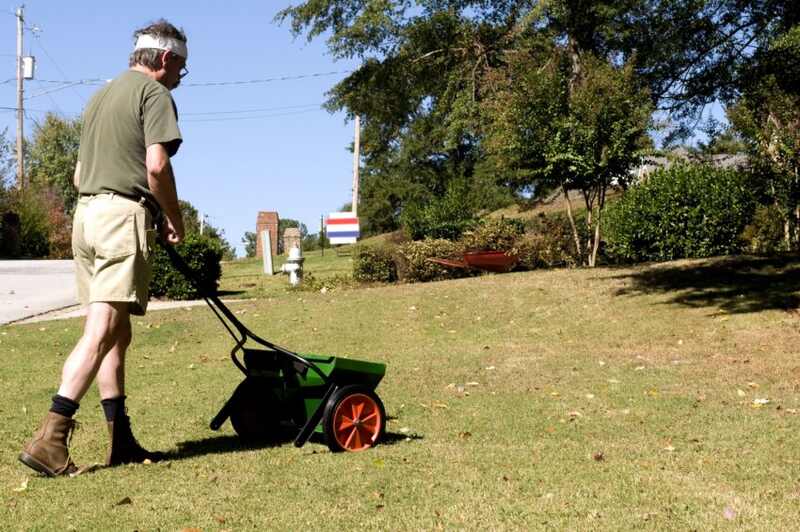
More fertilizer does not equal better results. In fact, the opposite is true. Too much fertilizer can cause more harm than good.
Your lawn should only receive the amount of fertilizer and nutrients determined by a soil test. Fertilizer burn can occur when too much fertilizer is applied. This is because the fertilizer salts suck out the moisture from the root system, causing your lawn to have brown spots.
Solution: Submit a soil sample for laboratory soil testing. Professional lab results will recommend the amount and type of fertilizer best suited for your soil.
7. Chemical Spill
Anything containing chemicals, such as gasoline, fertilizers, pesticides, and herbicides, spilled on your lawn can cause brown spots.
Solution: When you need to dispose of chemicals, don’t pour them on your lawn— follow the disposal directions listed on the product label.
8. Improper Mowing Techniques
Improper mowing habits might be stressing your lawn. If your mower blades are dull, the cut won’t be clean. The grass blades will tear instead, which can cause brown spots to occur on your lawn.
On average, your lawn mower blades need to be sharpened twice per year, but this will depend on how often you mow, how big your grass area is, and how long your growing season is. And remember, you can also shock your lawn by cutting off too much at once.
Solution: Check the sharpness of your mower blades during the spring and fall. And don’t forget to follow the one-third rule when mowing–– never cut off more than one-third of the grass blade during a single mowing session.
9. Problems with Watering
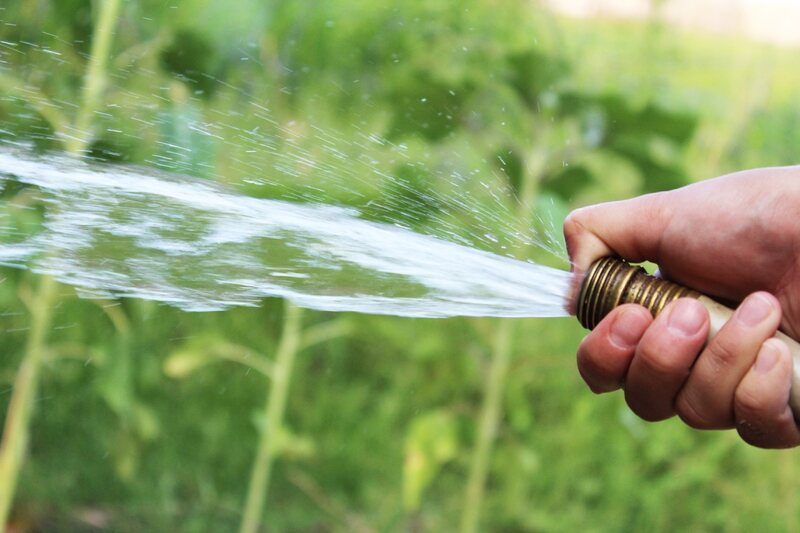
Most lawns need about one inch of water per week during the active growing season to thrive. Too little, too much, and watering at the wrong time can cause your lawn to have brown spots.
- Too little water (underwatering) can replicate drought-like conditions, which can create brown spots.
- Too much water (overwatering) can become a brewing ground for lawn diseases and pests, creating brown spots on your lawn.
- Watering at the wrong time can also make your lawn attractive to fungal diseases and pests because the lawn doesn’t have enough time to fully dry before nightfall. Water your lawn in the morning before 10 a.m.
Solution: Ensure your lawn receives the proper amount of water and adjust it if it’s not around one inch per week. You can use a rain gauge or a tin can to evaluate how much water your lawn receives.
10. Drought
During a drought, your grass might not receive the one inch of water a week it needs during the active growing season, especially if your county has watering restrictions. Drought can cause your lawn to have brown spots and go dormant.
Solution: Continue to check your area’s local watering restrictions to see if you’re able to adjust your watering schedule.
11. Dormancy
Both warm-season grass and cool-season grass have a period of dormancy that will cause your lawn to turn brown. Warm-season grass will go dormant in winter, and cool-season grass will go dormant during the summer and extremely cold winter temperatures. Dormant grass often appears brown.
Solution: There’s not much you can do here except wait out the dormancy period. If you have warm-season grass, you can overseed it with cool-season ryegrass to help extend the autumn green period.
12. Animal Waste
Picking up your dogs’ pooh is your least favorite task, but doing so is imperative to keeping your lawn green. Leaving your dogs poop on your lawn can cause brown spots.
Dog poop releases nitrogen, so when it’s left to break down entirely on its own, you’re essentially giving your lawn too much nitrogen, which causes brown spots.
Dog urine, as well as cat and rabbit urine, can also leave brown spots on your lawn.
Solution: Pick up the dog pooh as soon as possible and rinse the area with water from your garden hose to neutralize it. You can also use water to neutralize animal urine. Consider training your pet to go potty elsewhere.
13. Thinning Turf
Thinning lawns struggle to fight off pests and diseases. Thick, full lawns typically have a higher tolerance of pest and disease damage. If your lawn isn’t experiencing new growth, its once dense carpet will thin over time.
Solution: You can thicken up your turfgrass by overseeding once a year. Overseeding is the process of spreading grass seed over an existing lawn. Overseed warm-season lawns in late spring or early summer and overseed cool-seasons lawns in early fall.
When to Call a Professional
Some culprits of lawn brown spots are easy to identify. Drought, dormancy, and animal waste are pretty simple to evaluate. But pests or fungal diseases could take a more trained eye to identify and treat. Connect with a local pest control professional or lawn care professional if you suspect a pest or fungal disease is attacking your turfgrass.
Main Image Credit: Garrett Aitken / Canva Pro / License